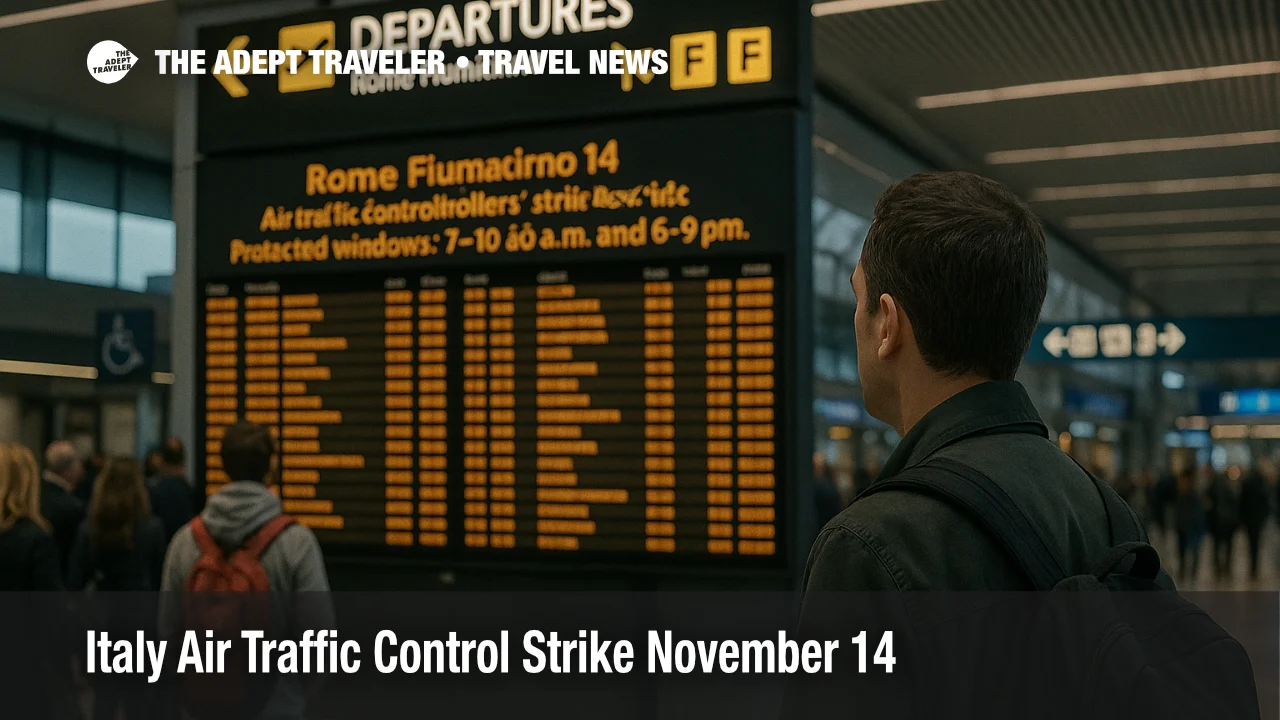Italy Air Traffic Controller Strike Nov 14, Protections Confirmed

Key points
- Italy's ATC stoppage is set for Friday, November 14, 1:00 to 5:00 p.m. CET, with nationwide impact
- ENAC confirms protected windows 7:00 to 10:00 a.m., and 6:00 to 9:00 p.m., when flights generally operate
- Parallel actions hit easyJet crews 1:00 to 5:00 p.m., and Volotea staff for 24 hours, increasing disruption risk
- Expect cancellations and retimes outside protections at Rome Fiumicino, Milan Malpensa, and other hubs
- Travelers should verify day of operations, and use carrier waivers or EU261 pathways for reroutes or refunds
Impact
- Check Your Flight 24 Hours Out
- Confirm departure time, terminal, and any automatic rebooking messages from your airline
- Aim For Protected Windows
- If possible, move to departures 7:00 to 10:00 a.m. or 6:00 to 9:00 p.m. local to reduce risk
- Know Waiver Options
- Use airline change-fee waivers where offered, same-day airport or date shifts may be permitted
- Plan Connections
- Build longer layovers, especially for evening bank links and last flights of the day
- Schengen Vs Non-Schengen
- For missed connections, understand separate-ticket risk, and where to clear exit, entry, and security again
Italy's air traffic control, ATC, workforce is scheduled to stop work nationwide on Friday, November 14, from 100 to 500 p.m. Central European Time. Travelers should plan for schedule trims and rolling delays, especially outside the legally protected operating windows. Expect the sharpest impacts at Rome Fiumicino Airport (FCO), Milan Malpensa Airport (MXP), and other busy hubs, with knock-on delays to evening connection banks.
What changed today is confirmation of the protection windows. Italy's civil aviation authority, ENAC, reiterates that during transport strikes flights in the 700 to 1000 a.m., and 600 to 900 p.m. local bands should generally operate, alongside a list of essential flights the authority designates. Outside those bands, cancellations and retimes are likely as providers slim schedules to match available staffing.
Layered actions will add friction. On the same day, easyJet flying crews are set to stop from 100 to 500 p.m., and Volotea staff have a 24-hour national strike. These airline-specific actions can remove capacity on otherwise protected routes, and they complicate recovery after the ATC stoppage ends.
How Italy's protections work
Italy's "fasce di garanzia," or protected bands, are minimum-service windows that keep defined flights running to preserve essential mobility. ENAC also maintains a list of indispensable flights, for example medical, emergency, or certain island services, that should operate regardless of strike timing. Airlines still retime, consolidate, or swap aircraft to concentrate activity inside those bands, so your original flight number may change even if your itinerary stays intact.
Latest developments
The transport ministry's strike calendar continues to show the November 14 actions in the air sector, including ENAV air traffic control personnel and multiple airline groups. Local transit stoppages in Rome and other cities on the same date can affect airport access, so build more time for curbside, rail, and bus connections.
Practical playbook for the day of travel
If you can, move your departure into a protected window. Morning departures between 700 and 1000 a.m., or evening departures between 600 and 900 p.m., have the highest odds of operating. Mid-afternoon flights during the 100 to 500 p.m. stoppage are most exposed to cancellation or long holds. For connections, avoid the last bank of the day into southern, island, or secondary airports that have limited back-up flights.
Rebooking pathways differ. If your carrier issues a no-fee change policy, use it early to move into a safer band or to an alternative airport served by the same ticket. For cancellations or delays of 3 hours or more on departures from Italy or on EU carriers, Regulation EC 261 may apply, with duty of care and, in certain cases, compensation, though strikes can affect eligibility. If you booked separate tickets, the onward airline has no obligation to protect your connection, so consider proactively re-timing the second ticket.
Schengen and non-Schengen flows add time. At Rome Fiumicino, Milan Malpensa, Venice, and others, many long-haul itineraries require a Schengen exit or entry plus security and, sometimes, terminal changes. Build extra buffer if your inbound falls during or just after the stoppage, because banks that launch after 6:00 p.m. can still feel residual delay.
Airport access matters too. If local buses or metro lines in Rome or other cities slow or pause, airport trains can crowd, and taxi queues lengthen. Leave earlier than usual, and verify ground transport status before leaving for the airport.
Final thoughts
The "Italy ATC strike November 14" story is straightforward, protections are real, but capacity will still be trimmed to fit a four-hour staffing gap. If you are booked, shift to the protected windows where possible, verify your flight 24 hours out and again the morning of travel, and use any carrier waiver you are offered.
Sources
- Voli garantiti in caso di sciopero, ENAC
- Ministero delle Infrastrutture e dei Trasporti, Calendario Scioperi
- Idealista, Italy transport strikes in November 2025
- Telepass Moveo, Sciopero aerei del 14 novembre 2025
- Aeroporto di Napoli, Avviso sciopero Volotea 24 ore
- Wanted in Rome, Strikes in Italy to affect air travel in November
